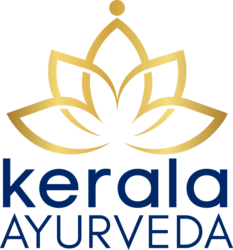Study the 'Heart of all the Eight Branches of Ayurveda' verse by verse with an Ayurvedic scholar
15 Weeks - Live streamed
Guided by a master clinician, you’ll learn the Ayurvedic principles from the root Vedic text, Ashtanga Hridayam. Join us live or purchase a past session recording to focus on topics of your interest.
- Uncover the deepest meaning behind the Ayurvedic principles as outlined in the root ancient text
- Experience the richness and healing power of the ancient Sanskrit verses
- Indicators of a poor disease prognosis and fatal signs
- Signs from nature, dreams and auspicious events that confirm an individual is transitioning the physical plane, or that suggest a speedy recovery and good health
- Earn PACE credits as a NAMA member
It's not too late to join
Course Information
- Schedule: Feb 14 – May 22, 2024
- Day & Time: Wednesday evenings 6:00-7:30pm Pacific
- Format: Live streamed
- Estimated Time: 15 Weeks
- Hours: 22.5
Earn Continuing Education Credits: Students are encouraged to submit their program to the National Ayurvedic Medical Association for PACE credits upon completion.
Who should take this course?
No prerequisites
This course is designed for Ayurvedic students, professionals and enthusiasts.
There is no prerequisite to join, though we recommend a foundation in Ayurvedic principles to support your comprehension of the material. If you’re new to Ayurveda, you may be interested in our Principles of Ayurveda all online course or our Ashtanga Hridayam recordings, which include earlier parts of the series covering foundational Ayurvedic principles.
If you are new to Ayurveda, this course will set a stellar foundation for your studies. If you have already commenced your studies in Ayurveda, journeying into the root text will allow you to immerse yourself further and become truly outstanding in the field.
Student stories
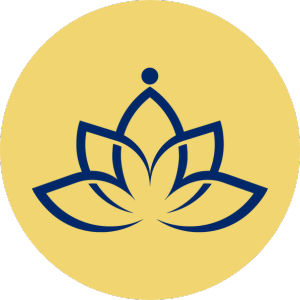








How can I apply knowledge of Ashtanga Hridayam?
- The Ashtanga Hridayam offers practical health principles and guidelines. You’ll be able to apply this information to your own health and wellbeing.
- You can share your knowledge with family and friends to support their wellbeing.
- As an Ayurvedic practitioner, this course will provide training in general Ayurvedic principles and methodologies that you can implement in your client-based practice. Learning straight from the root Vedic texts provides an excellent foundation in traditional principles.
- If you’re a health professional, you can apply Ayurvedic knowledge from the Ashtanga Hridayam into your practice to support your clients with ancient, time-tested wisdom.
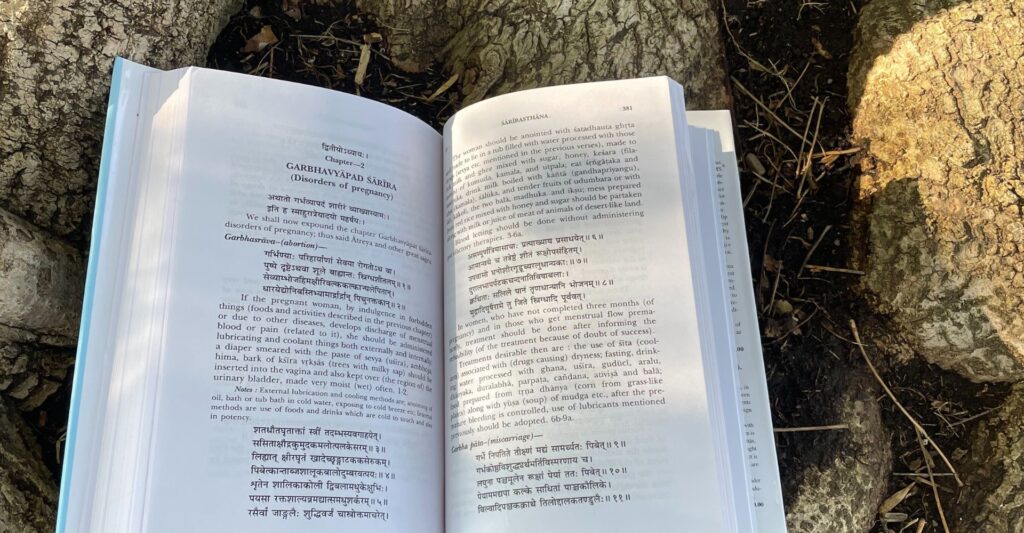

Schedule
Classes are live streamed Wednesdays from 6:00-7:30pm Pacific
Part 18 Dates
Feb 14, 21, 28
Mar 5, 12, 19, 26
April 3, 10, 17, 24
May 1, 8, 15, 22
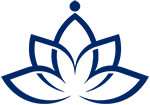


Format
How can I attend class?
LIVE ONLINE LEARNING
Your course is conducted 100% live and online via Zoom. You’ll be able to interact with your faculty and ask questions as you explore the rich ancient wisdom of the Ashtanga Hridayam.
CLASS PLAYBACKS
All classes are recorded, so if you miss a session or wish to review previous material, you can view the playbacks at your convenience in our elearning portal.


Live streaming technology
We introduced live streaming technology to our Ayurvedic education in 2015. Our classes are currently conducted using Zoom and provide students an opportunity to study live and interact with faculty. Zoom can be accessed on mobile, tablets, laptops and desktop devices. All live streamed classes are recorded for later viewing in our elearning system.



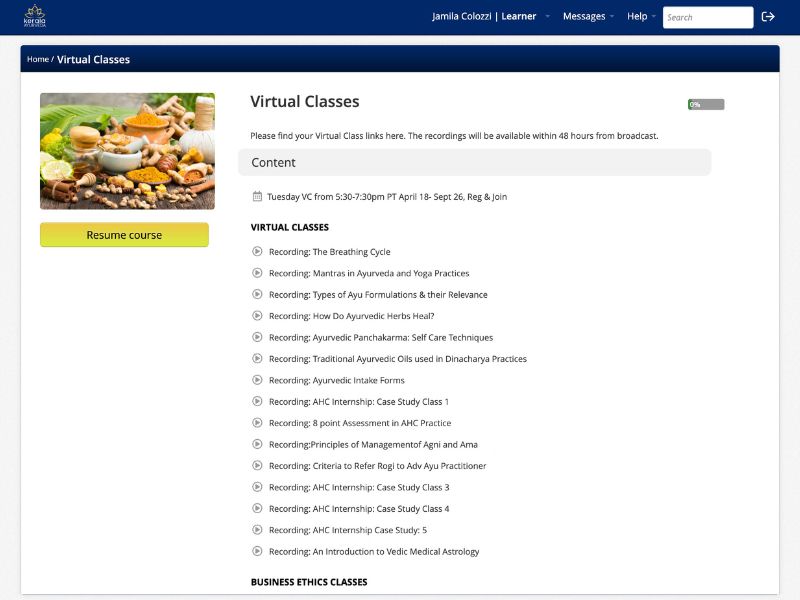

Elearning
Our courses are powered by a robust elearning system that connects our global community of students and faculty. The elearning portal is where students may access all of their course information, materials and curriculum, including: schedule, class slide decks, class notes and links to live streaming class sessions. The elearning portal is also where tests and assignments are conducted, and where students may submit questions.
Curriculum
The Ashtanga Hridayam, the “Heart or Essence of all the Eight Branches of Ayurveda,” is one of the primary ancient root texts of Ayurveda. Today, the Ashtanga Hridayam continues to serve as a root source for Ayurvedic philosophy and protocol, providing clear guidelines in all aspects of health.
As an Ayurveda student, practitioner, or enthusiast, you know how important it is to use the authentic teachings of the ancient Vedic texts. During this series, you will be guided through the Ashtanga Hridayam word-by-word, illuminating the deepest aspects of the Ayurvedic principles. You’ll learn to chant the slokas, experience the richness of the beautiful ancient verse and feel the healing vibration of the words – the heart of Ayurveda!
Part 18 Topics


Sareerastahana – Chapter 5 – Vikriti Vijnaniyam
• Importance of knowing prognosis of a disease and fatal signs
Indicators of poor prognosis
• Altered sensory perceptions indicating poor prognosis
• Fatal signs based on the events happening around the individual
• Importance of having the knowledge of prognosis from the indicators from the nature
• Indicators from an individual's health state that they will transition from the physical world


Sareerastahana – Chapter 6 – Dutadi Vijnaniyam
• Indications from the nature and the messenger about the prognosis of the case
• Auspicious indicators and events happening with the physician, messenger and the individual demonstrating the prognosis
• Auspicious omens indicative of speedy recovery
• Inauspicious indications from the surrounding while the physician is on the way to see the individual
• Dreams and health indicators from the nature of dreams
• Signs of good health
Faculty
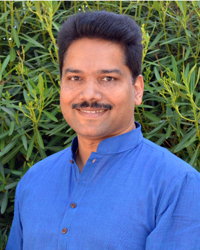

Vaidya. Jayarajan Kodikannath (BSc, BAMS)
Vaidya. Jayarajan Kodikannath is a classically trained Ayurvedic Doctor and an accomplished teacher representing a lineage of Ayurveda practitioners from Kerala, India currently working as the Executive Vice President of KAL India and CEO of Kerala Ayurveda (USA).
Suffused with expertise in Traditional Indian Medicine (Ayurveda) practices especially Panchakarma (Ayurvedic detoxification), a specialty of Kerala Ayurveda tradition, Vaidya. Jayarajan worked as the Chief Medical Officer of the award-winning Ayurvedic Health Resort, Ayurvedagram in Bangalore, India for more than 10 years before relocating to the U.S. in 2010.
He is currently the President of the National Ayurveda Medical Association (NAMA). He is an accomplished teacher for the advanced courses in Ayurveda and the resource person for various training programs conducted in traditional Ayurvedic therapies and medicine. He was on the Board of Directors of California Association of Ayurvedic Medicine (CAAM) and on the Curriculum Board of Bastyr University to create the Masters in Ayurveda program. His corporate sessions and workshops on applications of Ayurveda in daily life, stress management and BMS (Body, Mind & Soul) are immensely popular.
Vaidya. Jayarajan is actively involved in various research projects of Kerala Ayurveda. He has presented several papers on Ayurveda in national and international seminars. His debut publication The Parent’s Complete Guide to Ayurveda can be found wherever books are sold.
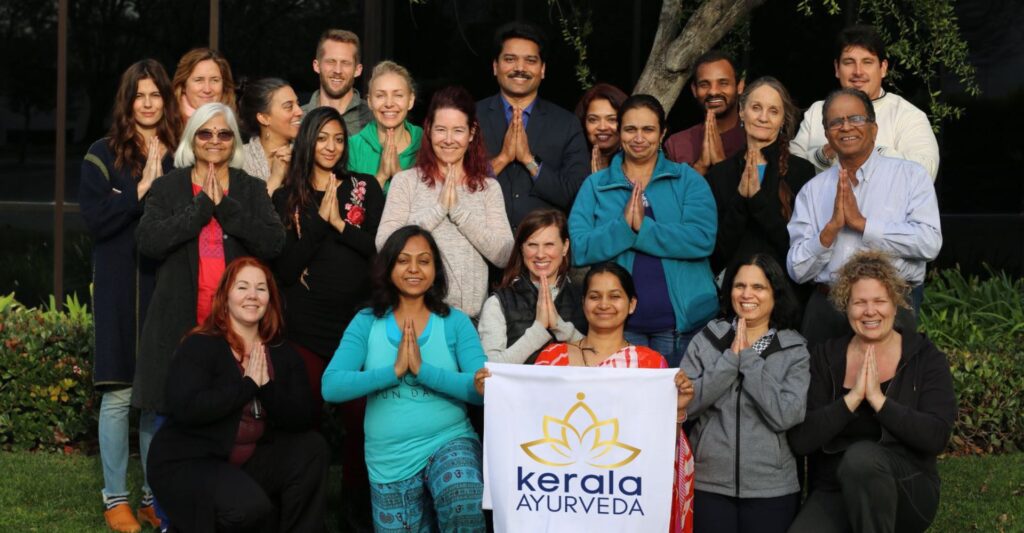

Student & Alumni Benefits
At Kerala Ayurveda Academy, we value the bond with our students – that’s why we call ourselves the Kerala Family! As part of the Kerala Family of students, you’ll receive expert support and guidance throughout your program.
Support during the Ashtanga Hridayam program
- During the live streamed classes, online students can interact directly with class moderators and faculty.
- Mentors are assigned to all students so they can receive guidance and support from Kerala Ayurveda’s seasoned practitioners.
- Student Support is available anytime to assist with educational service planning and tuition management.
Join the program
NEW STUDENTS TO KAA
$370
KAA STUDENTS & ALUMNI
HAC, AHC, AP, AD and PKT Programs
